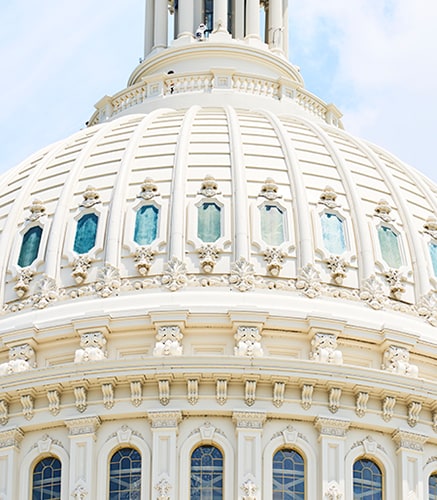Passed into law on July 4, the One Big Beautiful Bill Act contains significant changes across the tax landscape — including for estate planning, businesses, investors and charitable giving. Below, we answer several of the most pressing questions we have received since the passage of the bill. For actionable planning insights and additional analysis on the provisions discussed below, please see Beyond Sunset: Tax Planning for the One Big Beautiful Bill.
Estate Planning
Is the estate tax exclusion changing for 2025, and what will it be in 2026?
Taxpayers will have, for the first time in over 20 years, an ability to make plans without worrying about the exemption amounts changing (up or down) in the near term. There is no change to the current $13.99 million exemption for 2025. The exemption increases to $15 million per person ($30 million for a married couple) in 2026 and will be indexed for inflation thereafter. There are no sunsets or phaseouts of these provisions, so changing them in the future would take an act of Congress.
Is there any change to the gift tax annual exclusion?
The OBBBA does not change the gift tax annual exclusion, which remains at $19,000 for 2025. The rules provide for inflation adjustments, but we will not know the number for 2026 until this November.
Will taxpayers still get a step-up in basis upon death?
Yes. The law did not make any changes to the basis step-up rules.
Does the law make it easier to make lifetime gifts to minors?
There are two provisions of the law that impact giving to younger children and grandchildren. The first is an expansion of the types of expenses that can be paid from a 529 plan account. These accounts offer the opportunity to save tax-free for a child’s future education. The OBBBA expanded the types of qualifying expenses for K-12 education, test fees, the costs of licensing and accreditation, as well as equipment. These changes will make 529 accounts more valuable, even for those who are not focused on saving for college.
In addition, the law created a new type of IRA account for minors (no earned income needed) called Trump accounts. Beginning next year, up to $5,000 can be contributed to a minor child’s Trump account. This is a tax-deferred arrangement; assets withdrawn are taxed upon withdrawal like a traditional IRA. In addition to family contributions, the OBBBA calls for the federal government to contribute $1,000 for each child born between 2025 and 2028. There are a few caveats: No one can establish a Trump account before July 4, 2026; no one yet knows for certain what the structure will be, but we are reliably informed that the accounts will be opened directly with the U.S. Treasury Department; and the statute strictly limits the permitted investment of these funds to certain types of index funds.
Individual Income Tax Provisions
Are individual income tax rates going up?
No. The individual income tax rates adopted in 2017, with a 37% top rate, are extended indefinitely under the OBBBA. There are also no changes to the rates applicable to capital gains.
Will my income from social security be taxed?
The OBBBA does not eliminate the taxation of Social Security benefits. What it does provide is a higher standard deduction for individuals over age 65 and a $6,000 tax deduction for individuals over 65 who have income under $75,000 for single filers or $150,000 for married couples filing jointly.
Which tips and overtime are not taxable?
The OBBBA did not make these items tax-free. Instead, it introduced deductions for tipped income and overtime pay for taxpayers with income under a specified level. It has not yet been determined by the Treasury Department which professions will be able to deduct income from tips. Payroll taxes will apply even if the amounts are deductible for income tax purposes.
Are there changes to what items are deductible for income tax purposes?
Yes. There are a few changes to the law on deductions. First, non-itemizers are entitled to certain deductions, including the deductions for seniors, for overtime pay and for tips, as long as they meet the income limits. Second, the deductions that were eliminated under the 2017 Tax Cuts and Jobs Act, such as moving expenses, personal exemptions, casualty losses and gambling losses, are eliminated indefinitely under the OBBBA. Third, for individuals in the top 37% tax bracket, there is now a cap on itemized deductions, which cuts off deductions equal to 0.54% of adjusted gross income.
What about the SALT cap?
The cap on the deductions for state and local taxes (SALT) was extended indefinitely. In addition, for the period 2025 to 2029, the cap is increased from $10,000 to $40,000 for individuals with less than $500,000 in income. The extra $30,000 is phased out for taxpayers with adjusted gross income between $500,000 and $600,000. Individuals making more than $600,000 through 2029 and everyone beginning in 2030 or later are limited to the $10,000 SALT cap.
Can I deduct Interest paid?
The home mortgage interest deduction stays in place with the limits from 2017 made permanent. There is a new deduction of up to $10,000 for interest on a loan to purchase a new U.S. built car acquired from 2025 through 2028. This is phased out for taxpayers making more than $100,000 (single), $200,0000 (married filing jointly).
Effective Dates: Individual Tax Provisions
| PROVISION | START DATE | END DATE |
|---|---|---|
| $15 M estate tax exemption | 2026 | None |
| Deductions for seniors, tipped income, overtime income | 2025 | 2028 |
| Create Trump accounts | July 4, 2026 | None |
| Government contributions to Trump accounts for babies | 2025 | 2028 |
| Floor on charitable deductions | 2026 | None |
| Ceiling on itemized deductions for 37% bracket | 2026 | None |
| Charitable deduction for non-itemizers | 2026 | None |
| SALT Cap of $40,000 | 2025 | 2029 |
| Rooftop solar credit | 2017 | December 31, 2025 |
| Electric car credit | 2017 | September 30, 2025 |
| Expansion of permitted payments from 529 account | July 4, 2025 | None |
| Interest on domestic car loan | New car purchased 2025 or later | 2028 |
| Credit for contributions to scholarship funds | 2027 | None |
Charitable Giving
Will I still be able to deduct my charitable contributions?
There are several changes that will impact charitable giving. First, there is a new $1,000 above-the line charitable contribution deduction for non-itemizers, similar to the $300 provision we saw during COVID. Second, beginning in 2026, charitable contributions will only be deductible to the extent they exceed a 0.5% of Adjusted Gross Income (AGI) floor. If you have income of $500,000, only your charitable contributions in excess of $2,500 can be deducted. This is in addition to the ceiling on all itemized deductions applicable to those in the 37% bracket. Third, the endowments of private colleges and universities with over 3,000 students will be subject to an increased endowment tax that is based on their endowment per student ratio. Note that none of these new limits impact Qualified Charitable Distributions (QCDs) from retirement accounts, which remain a key charitable giving strategy.
How does the tax credit for contributions to scholarship funds work?
There is a new tax credit for up to $1,700 contributed to a qualified scholarship organization, beginning in 2027. A credit is more valuable than a deduction because it is a dollar for dollar reduction of the tax bill. There are no income limits.
The statute requires state approval for scholarship funds to be created in your state, and the funds themselves must meet federal and state requirements to qualify. They must be for primary or secondary education (not college) and the recipients must meet certain standard criteria as well. In addition, there is an overall cap in the number of credits available each year, so taxpayers will have to apply for the credit. There will be a lot more to learn about these between now and 2027.
Investors and Business Owners
Are qualified opportunity funds over?
No. While the chance to invest in existing Qualified Opportunity Funds (QOFs) wraps up in 2026, with gains deferred under those funds realized then, the OBBBA provides for new opportunity zones and QOFs to be established in 2027 and thereafter on a 10-year basis. The new funds will be divided into two categories: Qualified Opportunity Funds and Rural Opportunity Funds, with greater tax benefit available for investors in Rural Opportunity Funds.
This creates new options for excluding gain on sale transactions, deferring the recognition of gain on sale transactions, and avoiding gain on earnings in the fund.
Are there any changes for qualified small business stock?
Yes. New provisions expand the businesses that can qualify as QSBS by increasing the maximum size of the business at the time of investment to $75 million. In addition, the floor on the maximum amount of capital gains that can be excluded from income after five years is increased to $15 million. This means more investors will qualify for the exclusion. Since this is only available for investments in C corporations, this is a new factor to consider in choosing an entity type for a new enterprise.
Is there any change to the taxation of carried interest?
No. There is no change to the taxation of carried interest in the OBBBA.
Provisions That Impact Businesses
Will 100% bonus depreciation be coming back?
Yes. Both 100% bonus depreciation and 100% expensing of domestic R&D are back in 2025.
Are the clean energy tax credits gone?
The clean energy credits are repealed, but there are staggered effective dates between 2025 and the end of 2027. Those in the process of implementing clean energy improvements for which the credit was available last year will want to determine the effective date of the repeal of the particular credit they were seeking.
Is there still a cap on the deduction of business interest?
Yes. There is still a cap on the deduction of business interest. However, the cap is higher because it will now be based on EBITDA, as it was before 2022.
Can corporations deduct charitable contributions?
Yes, but in 2026 and beyond, it will be limited to contributions in excess of 1% of taxable income.
When is the bill effective?
The legislation was enacted on July 4, 2025, but there are effective dates within the legislation ranging from 2022 to 2027. In addition, some provisions are only applicable for tax years 2025 to 2028. Generally speaking, it will be important to focus on the timing of transactions to take full advantage of the changes. There are a few situations where a taxpayer, most likely a corporation, will want to amend returns from prior years to capitalize on favorable provisions with retroactive effective dates. See the chart below for effective dates.
Effective Dates: Business Tax Provisions
| PROVISION | START DATE | END DATE |
|---|---|---|
| 100% Bonus Depreciation | January 19, 2025 | None |
| Expensing Domestic R&D | 2025 | None |
| QSBS (purchase date) | July 4, 2025 | None |
| Opportunity Zones | 2027 | New ones created every ten years |
| Business Interest Cap Increase | 2026 | None |
| Charitable Deduction 1% Floor | 2026 | None |



